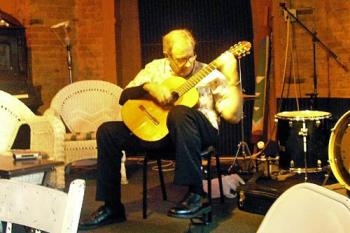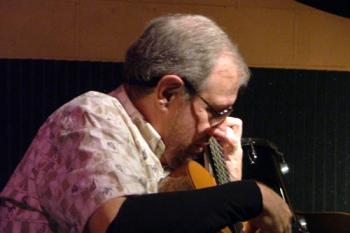Larry Johnson Presents the Music of Sor (September 10, 2007)
This evening members of the Rochester Guitar Club enjoyed a discussion of the music of Fernando Sor and some delightful examples of Sor’s music as presented by member, Larry Johnson. Larry has specialized in the life and music of Sor for many years and has taught guitar at both Roberts Wesleyan College and Nazareth College where, in 1974, he was this institution’s first guitar teacher. Larry also discussed classical guitar technique in general, particularly the issue of fingernails and the question of authenticity in early music. I must admit that I became so absorbed in Larry’s discussion that it was difficult to focus on my note taking! Larry is a many faceted gentleman with a broad and deep knowledge of music, language, history, and technology, probably much as Sor himself was.

Larry’s personal experience as a guitarist began at a young age with pop and rock music. However, his father, who was a viola player in the Rochester Philharmonic Orchestra, encouraged him to learn classical music by giving him a recording of Segovia’s playing. That record included Sor’s Variations on a Theme of Mozart and it inspired Larry to purchase “Twenty Four Progressive Lessons,” along with Variations on a Theme of Mozart (Upon trying this piece, Larry could not imagine how anyone could play music of this level!). Sor is a good place to start learning classical music since he was a teacher himself. Larry is an experienced concert performer and has been interviewed in magazines such as “Guitar Player” and “GuitArt.” He has recorded all the works of Sor and these recordings are available on the internet at CRG Recordings.
In his discussion of technique, Larry stated that there is no absolute right way to play. Technique is a means to an end. Whatever produces the right sound is the right way. Larry concurs with Segovia in this approach. He has also studied with Alexandria Lagoya, Christopher Parkening, Ida Presti and Oscar Ghiglia among others.
Fingernails were not commonly used by guitarists prior to Segovia’s time. It was Segovia who developed the modern use of nails, the development of nylon strings, and the use of the guitar as a respectable classical instrument. Some earlier players have felt that the bare fingertips produce a more natural, warm tone. Segovia was very much in favor of using the nails and his view has generally prevailed.
Larry has had a lifelong problem with his own natural nails and has experimented with a number of commercial products. Some of these helped his playing, but were harmful to the fingers. He finally settled on metal nails that he made himself in a machine shop and tapes on his fingers with electrical tape. He had considered patenting these, but encountered serious obstacles from the Patent Office. Larry also wears a cutoff sock as a sleeve on his right forearm to avoid damaging the finish of the instrument.

Many players strike the string with the left side of the fingernail, Segovia included. Others such as Lagoya and Johnson use the right side of the nail. This is another example of finding your own style and technique. As for the left hand he advises simplifying left-hand positions so that the hand uses minimum movement up and down the fret board. In response to a comment on how relaxed Larry seemed, he discussed the athletic aspect of playing and the importance of relaxing the muscles.
Larry gave us a printed summary of his discussion including the sheet music for three of Sor’s pieces. For his first illustration of Sor’s music he performed these three pieces for us. These were student-level etudes, an enjoyable introduction to Sor’s music.
Sor was a guitarist before the use of nails became common. Consequently, many players today feel that to play his music authentically, a modern guitarist should not use nails either. Larry feels that this obsession with authenticity has been carried too far. It is not really possible to play exactly as another player does, not even if that person is still alive, or if we have their recordings. He feels that authenticity is overstressed by many players. No one can be sure exactly how a piece of music was actually played. Sor is often interpreted today as a classical composer, but he was equally a romantic composer. For this reason, Larry adds a variety of tone color into his music even though these techniques are not written in the score. He also uses his nails in performing Sor’s music simply because he feels that it sounds better. Nor does he use gut strings which were the ones used in Sor’s day. The current generation of players from the conservatory plays with much better technique than in the past, but is unnecessarily hung up on the question of authenticity.
Larry’s second performance included etudes on a concert level. It seemed to me that his playing became increasingly sensitive and expressive as he and the audience warmed up to each other. For those who would like to look them up on the internet, these are the pieces he played.
Opus 6, # 12
Opus 31 # 20, a study of block chords
Opus 6, # 6
Opus 6, # 11, a study of arpeggios
There was much spirited discussion by the members, and each question elicited an in-depth discussion by Larry of a particular point. When questioned about Sor’s background, Larry gave us a history lesson on Catalonia, and how it was captured and dominated by the Castilian Spanish. The Catalans were the largest minority in Spain, yet their language became illegal. All this came about, about ten years before Sor’s birth. Fernando Sor’s name in Catalan would have been Ferran Sors, but Spanish forms were used for political reasons.
Sor studied music at Monasterio de Montserrat near Barcelona. By early 1808, he had become a loyal Spaniard in sympathy with the weak and ineffective government of Charles IV. In June 1808 Joseph Bonaparte, brother of Napoleon was appointed king of Spain and by 1810 Sor supported him. Joseph treated the Catalans well which did not endear him to his brother, Napoleon. For the most part, the Catalans were very supportive of Joseph which made them suspect in the eyes of the Spanish authorities. When the Spanish defeated Napoleon, over 10,000 Catalans (they were labeled “afrancesados”) loyal to Joseph, including Sor, were forced to flee from Spain. From Spain, Sor traveled to Paris, England, Russia, and Berlin, always returning to Paris. He has received little recognition in his own country even today, there being only one very small street dedicated to him in Spain. Even Segovia did not consider Sor an important composer. The guitar itself became unpopular after Sor’s time until the overwhelming success of Segovia. Much of this decline was due to the increasing complexity of orchestral music and the popularity of the piano. As a consequence, much of Sor’s music was not well known before the 1970’s.
Larry’s final performance of the evening began with his interpretation of Sor’s most famous piece, “Variations on a theme by Mozart.” This is perhaps not Sor’s best work, but may well be his most popular with over eighty-seven recordings to date.
Larry brought his presentation to a close with sensitive renditions of opus 6, # 9 and opus 6, # 7. Larry was in full stride by this point and it was with great reluctance that we brought the meeting to a close shortly after 9 pm with a standing ovation. He was ready to play more Sor, and we certainly could have listened to more!
R. Taglieri
Photos: J. Clark
Share this page: ![]() Facebook
Facebook
![]() Del.icio.us
Del.icio.us
![]() StumbleUpon
StumbleUpon
![]() Digg
Digg
![]() Reddit
Reddit
Home ::
About Us ::
Events ::
Articles ::
Resources ::
Contact Us ::
Links
©2007-2008, Rochester Guitar Club, All Rights Reserved, This page last updated 2010-02-27 11:24:32
Website by Red Beagle Web Development.








